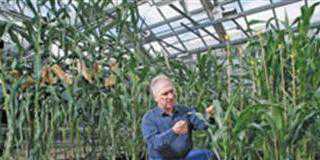Global warming might have a devastating impact on apple production in the Western Cape, Wiehahn Steyn from the Horticulture Department of the University of Stellenbosch said at the Cape Pomological Association’s climate information seminar held recently in Stellenbosch.
Temperatures in the Western Cape have been predicted to increase by 1,25ºC and rainfall to drop by 6% per year and 15% during winter by 2035 under the best-case scenario. The worst-case scenario predicts temperatures rising by 2,5ºC to 3ºC in summer; 2,5ºC up in spring and autumn; and 2ºC up in winter – while overall rainfall is projected to fall by 16%, with a 25% drop in rainfall in spring and winter. This worst-case scenario is unfortunately also the best-case scenario for 2050.
Prof Stephanie Wand from the Department of Horticulture at the University of Stellenbosch said that global warming might affect apple production positively due to increased carbon dioxide levels, which might result in increased reproductive and vegetative growth. Apple yields might even increase by 30% due to the higher carbon dioxide levels. Higher temperatures, however, have an extremely negative effect on chill units, resulting in increased problems with delayed foliation and fruit colouring. Greater sunburn damage will also result in lower pack-out percentages for some cultivars.
There has already been a 50% reduction in chill units in May over the past 35 years, in some areas, and chill units in this month are expected to halve again over the next 10 to 20 years. The apple industry is already experiencing problems due to the reduced chill units, and Wand expects it to be a matter of time before other fruit industries that have chill requirements, such as the apricot industry, also start to experience problems. Water requirements are also expected to increase due to the warmer temperatures, resulting in higher evaporation and transpiration levels.
The main apple-producing regions, such as Elgin, Grabouw and Villiersdorp, are predicted to be most affected by the changing climate, with increased temperatures and reduced rainfall resulting in more sunburn, delayed foliation and problems associated with fruit colouring. Ceres and the Langkloof might be only moderately affected, according to Steyn, and producers in the Kouebokkeveld might have to use rest-breaking agents, as is already done in the Grabouw region and on a small scale in Ceres.
Steyn identified Golden Delicious, Cripps Pink, Braeburn, Granny Smith and Fuji as cultivars posing high risks with climate change. “The risk associated with some of these cultivars might be reduced with shade netting or reflective mulching, but costs might render these interventions economically unviable,” Steyn said.
However red cultivars, such as Royal Gala, have improved strains and these cultivars might adapt better to the harsher climatic conditions. The ARC is also investigating and breeding improved cultivars that would be better adapted to changing production and market conditions.
Iwan Labuschagne from ARC-Infruitec says that Anna cultivar families have so far shown lower chilling requirements than most other apple families. Some of the Anna families, however, pose new challenges: for example, they struggle with prolonged dormancy and problems associated with bud break with reduced chilling requirements.
The changing climatic conditions do not signal the end of fruit production in the Western Cape. Steyn says that producers in areas such as Grabouw, Villiersdorp and Elgin would either have to use only improved strains in future or tswitch to crops that are better adapted to the new climatic conditions. Mediterranean crops, such as olives, pomegranates or figs; indigenous crops like fynbos, medicinal plants, hoodia or buchu; hardy temperate plants, such as guavas, peaches, grapes or persimmons; or adaptable subtropicals, such as cherimoya, avocados or citrus, might all be suitable alternatives to apples.
Steyn also advised farmers to use microclimates when establishing new orchards, which they should plant on south-facing slopes. – Glenneis Erasmus
Contact the University of Stellenbosch’s Department of Horticulture on (021) 808 4900.












